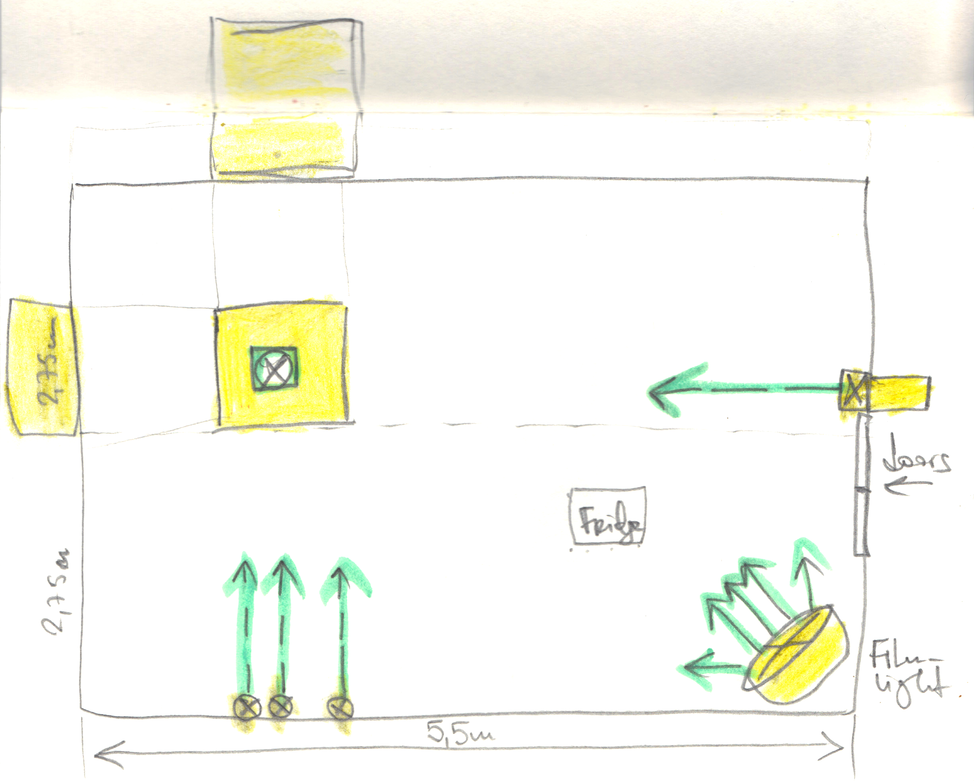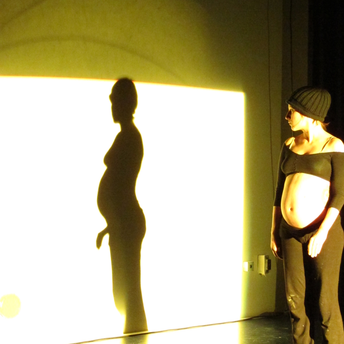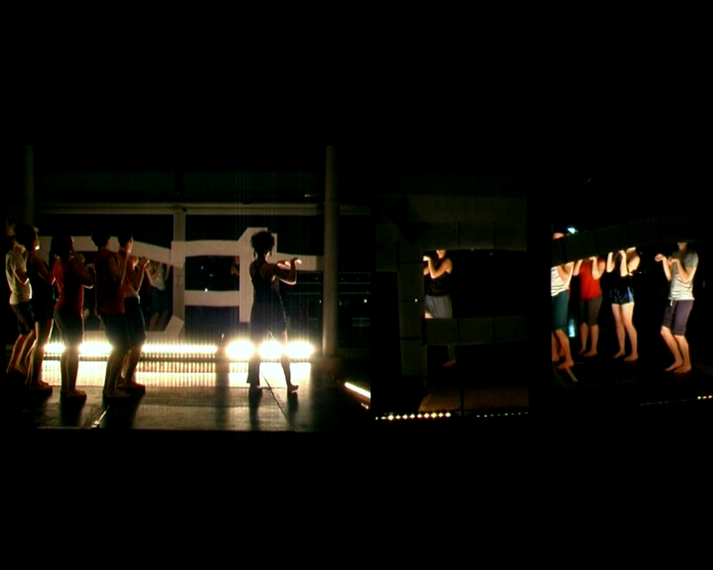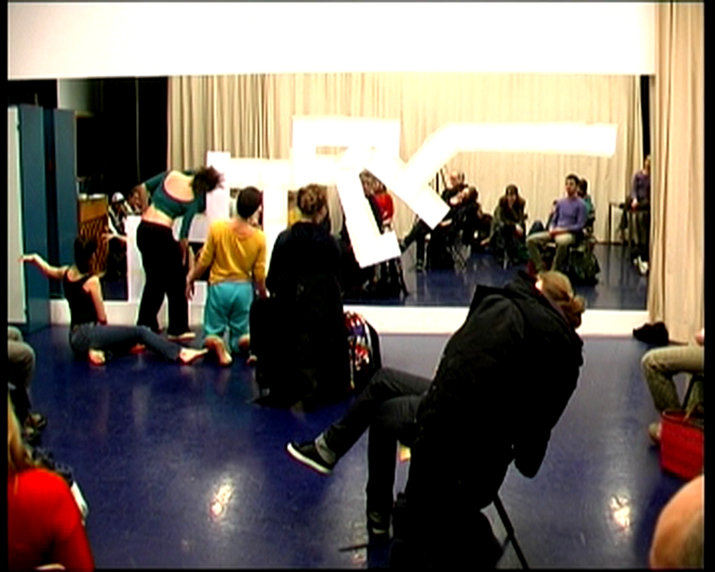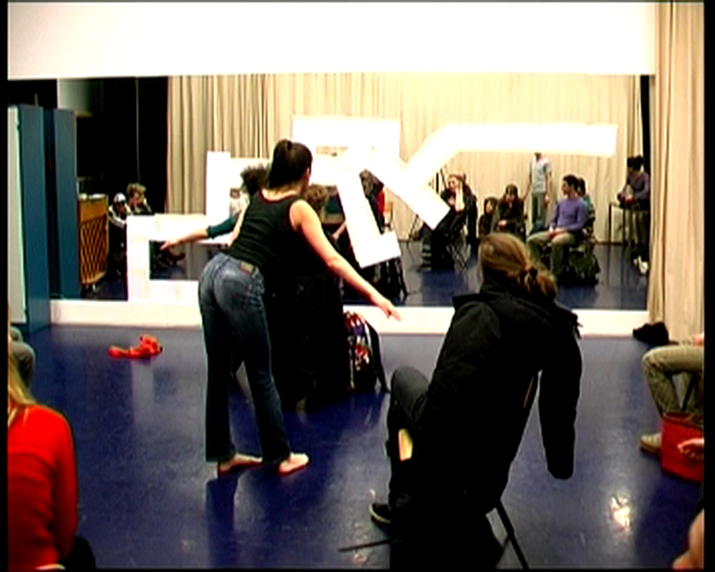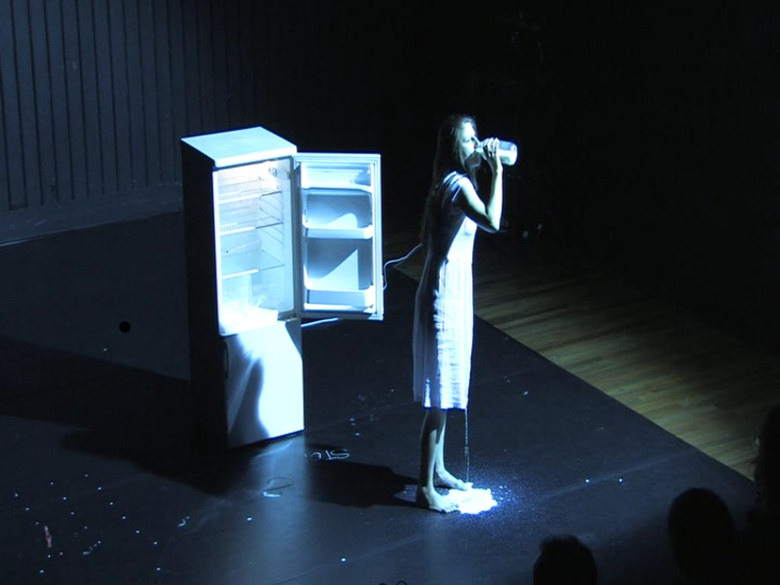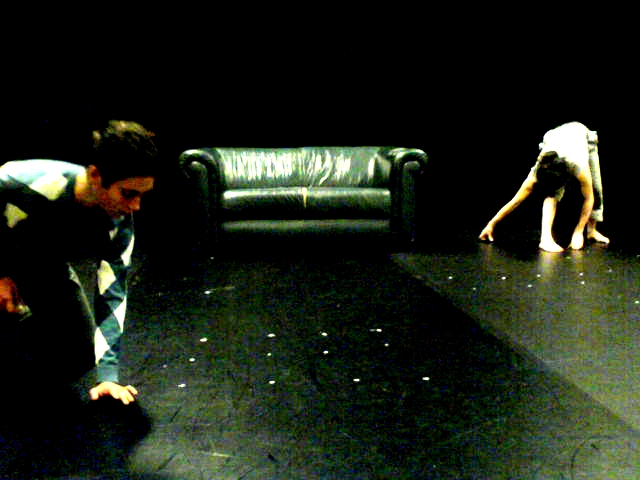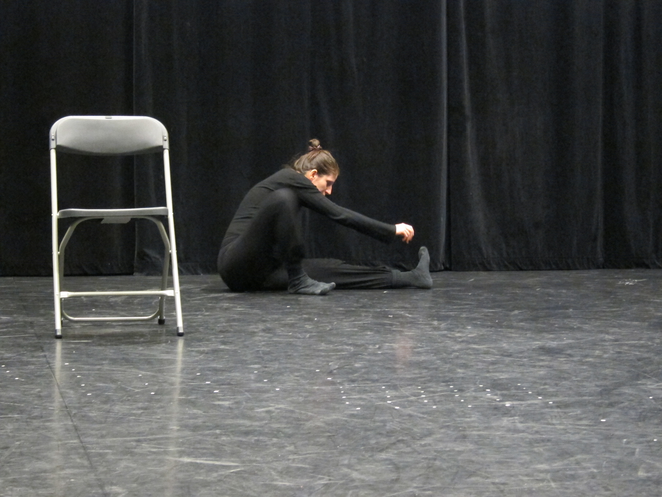Two years after I have found the double body, in the case-study of Mirror (stage) I read it differently then initially I did. Now I see that in the case-study of Mirror(stage) the real body is the body of a performer, the ideal body is the body projection in the mirror, and the body in the state of becoming is the tension space between these two. This body is seen by the audience as an effort, as a fixation, as a tendency to become. Audience could see it if they would sit on the side of the performing space, where they could see the performers from their profile. Then they would see performer's gaze. Effected by their own gazing and by the mirror effect, performers were transcending their bodies, they were going out of their own skin. By not being able to fully be in the projections of their bodies, in their ideal-self, they were caught in the in-between state of being.
* Glossary Glos"sa*ry, n.; pl. Gossaries. [L. glossarium, fr.
glossa: cf. F. glossaire. See 3d Gloss.]
A collection of glosses or explanations of words and
passages of a work or author; a partial dictionary of
a work, an author, a dialect, art, or science,
explaining archaic, technical, or other uncommon words.
[1913 Webster]
ONE DOUBLE BODY is the last phase of my study/research at Amsterdam Master of Choreography program (2009/11).
ONE DOUBLE BODY/Conversations with the Fish is also the performance I made as my graduation work.
My contribution to this catalogue will expose the research as well the meta-practice of making the performance.
Glossary*
Double Body:
1. is a method of a performer. According to Grotowsky (in his text “Performer”, reference: Miroslav Mandic, “Ruza Lutanja”) there is an I-I relationship in a performer's perception. There are two I's. The one that is allowing performer to be what s/he is performing, and the other one that is making performer aware of what is s/he performing (“the bird that eats, and the bird that see the bird eating”). In my understanding it is possible by using this method to make double directed action – an action towards performer her/himself and an action towards an audience. An action of the inwards direction and an action of the outwards direction. By using this method performer enables her/himself to be centred at same time in a moment of action and in a moment of meta-action. S/he is doing and reflecting on her/his doing in the same moment.
I embraced this method in my performing practice, as well in this choreographic research.
2. is a dynamic relationship between two bodies. The first is the real, self-existing, private body of a performer. The second is the ideal, desired, performed body.
Body of a performer – performed body. Between them is always a tension. This tension is based on a desire and on the work of a performer. While instrumentalising her/his desire (to become the ideal-self) performer is transcending her/his private body and becoming changed. In this process the third body is created. The state in-between the real body and the ideal body is the body in the state of becoming. This body is never the same. This body is always in the process. As soon as the real body is dragged to the ideal body, this body emerges. Then the real body is out of our sights. We can hint the ideal body, but actually what we see is only the body in the state of becoming. What we see as a material reality is only one body. Because of its processual nature, duality and potential that it contains, this body I call ONE DOUBLE BODY.
Glossary
Pregnancy
1. is my real-time pregnancy during second year at AMCh program. The last day of my first year at AMCh, I have met my mentor and friend Bojana Mladenovic. I was elaborating the past year, and I told Bojana that I became "pregnant" with my research/practice and that now I just need to wait, to nurture it until it eventually becomes a product. The same night I became pregnant in real life, without any intention or relation to what I said that day! From that day on, moments from my pregnancy persistently coincide with moments from my research (e.g. during finishing the work Prelude for a Causal Machine in which I was working with non-stop measuring of body-parts, I went to a regular ultra-sound for 20 weeks pregnancy, and there doctor was measuring body-parts of my baby for almost the same time duration as measuring in my choreography). During time of my research I was constantly working with my state. That's how the final presentation, ONE DOUBLE BODY, is based on these experiences: pregnancy, delivery, becoming a mother.
2. is my new approach to research and creative process in general, where I see the necessity for a period of gestation, for a period of invisibility of what is happening, for a belief that the research/project is still growing even when we don't see it in front of our eyes. This is an idea of surrendering oneself to the unknown of the process and in a way being prepared to die as we know ourselves. To let it go, as Benoit Lachambre would say.
Beginning of the shadow research, January 2011. Performed for the skype-update for my
AMCh colleagues who were in Cairo, while I was in our studio in Theaterschool, Amsterdam
Research with the light in the shadow part of the ONE DOUBLE BODY
The use of the light in ONE DOUBLE BODY was also a task of integration. How to use light within the causal machine concept? How to integrate light into the causality – like everything else: performers, space, time, bodies, room, etc? How not to use light just as a decoration (aesthetic information) or a technical support or just because we know we should use light? This research I have already started at beginning of the winter 2010. I set some basic conditions, light coming from 3 different sources and creating 3 different projections (shadows) of the body in space. The beginning idea was to use this setting to help me to lift the perspective from 2 dimensions of the floor/image (in the grid scene) into 3D space of the studio/room/stage. Also I wanted with these lights to create another space. Space inside of the space. Space that is the inside. An elevator of light into some other space, that is here, but also not the same here as the scene before (the grid). I wanted, as I always do, to use very simple means. Low-tech. Though, I have tried to use video projector. Just to tease my own standards. And it showed very soon that technology is unnecessary complicating everything and it doesn't bring any new quality. As I am working with the body of each of the performance elements, the same is with the light. Light has a body, and I have started looking at it. With Jeroen de Boer I could look at this body closely. Which reflectors/lamps create which kind of light? Under which angle this light falls on the wall/black curtain? How does a certain material reflect a certain light? What kind of projection creates particular light? How sharp or soft? What kind of frame for the lenses I want to use? Which filter colors to use? How reflectors/lamps stand in the space? etc.
Later on it became important how does the combination of these lights and projections work, and how can I use it for the causal machine composition. I started by using the same principles like in the Mirror (stage) but very soon I have realized that these principles were not enough, because, as some of my collaborators and mentors have noticed, the magnetism of the shadow was dragging me deep into myself and that have resulted in a very hermetic material. How to open the shadow-production for the audience to be able to engage with it? I have started to look not only what kind of shadow I am creating, but also how is my body in the space, and how does the whole composition look like. So I have invited people to have a look on what I am doing and help me see myself also from the outside. Some of the people I have invited to manipulate the lights, because I have discovered that the whole picture depends so much on the person who is manipulating the light. This person would be a co-creator of the performance. I wanted to look for visual artists, or artists that are both working in dance/choreography and in visual arts. They could be able to judge the production from the inside and from the outside, as supposedly they would be both familiar with the image (making) and with the performing (being an image). Last rehearsal before delivery was on 26th of February (I have delivered a baby on 8th of March*glossary: pregnancy). I was in the studio with Adam Beni, Gilad Ben Ari and Dragana Bulut. Adam and Dragana did each one run of light manipulation while I was performing. I was very slow because very heavy, but this gave a special quality to the performing. After delivery I have done runs with Adam as light-manipulator, but also Kyd C, Renee Copraij and Nina Djekic. After delivery my performance have changed. I was much faster and more diverse in movement production, but less settled.
Nina decided to work with me for the final presentation. We have worked for 2-3 intense weeks. At the beginning of our collaboration I was interested to maintain the impro aspect of performing the shadow. But after few try-outs in which we have noticed that the quality of performance varies a lot and depends on our energy levels, and that the images produced had a big potential which could easily be suppressed with the arbitrariness of improvisation, we have decided to learn how to use the vocabulary of already discovered material and to have more control over the performance. This led us into fixing the material and creating the score. Which was, in a way, an easy solution. In order to really develop the idea of the impro aspect, and actually the same openness of the performance of the shadow part as of the grid part, I think wewould need to practice together for much longer time. I have been practicing the grid for one whole year before final presentation. It became my daily practice. The same I wish I could do with the shadow. And to have only one collaborator to work with on this part. I believe that if the shadow would become our practice, we could perform it without setting and fixing material. The practice (of the grid) became a technique. A skill, knowledge, craft. New technique. Not known to anyone else except those who practice it. Therefore, it must be practiced in order to be shared.
In the piece ONE DOUBLE BODY I have employed all the concepts, principles and methods defined in in the above glossary of my research. ONE DOUBLE BODY had 3 different parts (Grid, Shadow and Object). I will expose separately the processes that led to their creation.
The Shadow
is the second part of the performance ONE DOUBLE BODY, as well as a part of the research. In this part I used both the agency and the causal machine methods.
In the shadow I used the agency of the shadow/light in order to produce a movement. I did the same like in the Mirror (stage) where I would make small, unintentional movement, in front of the mirror, and once I would see its reflection, I would let it to influence my next movement. This influence would happen intuitively, where I would follow either my aesthetic drive or just surrender myself to the need of the body to move. In the shadow I was constantly relating to what I see as one or more projections-shadows of my body. There were three sources of light (one light hanged on the sealing and two groups of lights laying or standing on the ground). This created three different plains of projection. My intention was to create a sensation of a cube out of these three plains.
Material was created by different means. Sometimes I would surrender myself to the desire to create images on the wall, sometimes I would create small broken narratives, sometimes I would make little drawings based on my need to paint with my body. In any case, I was avoiding the anthropocentric images, which meant, I was shaping my body not to look human. I used a lot my hair as a tool, because it contained different quality then body parts which often felt like a trunk. Only hands were different, they could create different shapes. Interestingly, these, head and hands, are body parts that are least used in dance.
The causal machine I used as a principle of composition. Once I would produce some material it would unavoidably influence the next one. There was no stop. Movement would come after movement, an image after an image. Everything would happen in a succession of a rhythm of the causal machine.
Research with the music for the ONE DOUBLE BODY
From the first moment, I was researching the shadow supported with Steve Reich music composition – 18 (Music for 18 Musicians). Back then, when I was looking for a music to support my research in the studio, I wasn't aware that what I have chosen fits so well, in its essence, my project. I was looking for something neutral – something without words and verbal meaning. The only music that was fitting that criteria, and which I had in my computer, was Steve Reich's music. Only later I realized that this specific piece works also with psychoacoustics (the study of the brains perception and reaction to all aspects of sound). The impact of this music on my mind (as a performer) was similar to the impact of the mirror when practicing the causal machine in front of it. It has made me to fall in some sort of trance and to be hypnotized with the certain magnetism that was produced with this music, or with the work of a mirror (reflecting and seeing the reflection).
From January 2011 on, Adam and me were working on music. We went through many different states of development of the music, but also we have shifted between few different concepts. First idea was to record different materials: from my rehearsals, from visiting midwife (sound of heart beat of our baby in my belly), from delivery, etc. At the beginning I was inspired with the diversity of the grid, so I wanted to gather the diversity of sounds and to use them as triggers during the grid, because I supposed to perform by myself (there was no second performer whose performance would trigger the visible causality during the performance). But this idea was outer regarding the concept of the causal machine. That would be representation of causality, not causality itself.
Sometime during the last days of my pregnancy, Adam and me bought one coconut. I took it in my hands and started shaking it. It was producing an amazing sound caused by shaking of its inside liquid. Adam thought to record it. We did so. I was shaking it and he had recorded it. The sound reminded us on the inside of the womb. For me the shadow was also standing for the inside of my belly, for the world of the Fish (nick-name for my baby while he was in my belly), a world without words, a world beyond human consciousness, beyond logos, beyond a reason. So this was fitting and we started using this sound next to the other sounds. After delivery we were working more intense and had a lot of trouble in understanding each other regarding music. I was actually attached to the music of Steve Reich, as I was so long using it for the shadow. Adam was asking me to be more technical and precise about what I want. As I was still researching, there was not one clear idea about music for me. But because of his pressure, the idea was slowly coming into its shape. We had few versions of the music for the shadow part. I didn't know what to do with them, because they were too full (Yael Assaf). They had too much meaning/syntax in it, and that was completely opposite to the shadow. So I have decided to reduce – to use only the recording of the coconut. Adam and me were coming to the solution from very different sides, but finally it was the same solution. We were thinking the same, but in different languages. I have noticed that for me it is hard to speak in music terms. Again, like with the light, I had to learn about sound itself. I had to understand it, and to deal with it as a separate body. Instead of dealing with some artificially composed, outer causality of the music, we turned into working with the inner causality of the recorded coco sound. Adam had created a matrix, a grid, of different modes (sound expressions) through which he had processed the coco sound. He says that the sound in the piece was always following the performance, coming just one second later. In his perception, this was causality between the piece itself and the music. There was also causality within the grid of modes. The modes were triggering each other in a causal way, taking from each other the original sound (coco) already transformed, and changing it again and again, but keeping the integrity of it. It was always one the same sound, just modeled and expressed in different //musical// scales. The same like my body in the grid, or like the shadow in the shadow scene.
I have planned to make music and sound for the whole piece. At the end music appears only in the shadow part and there is a one more sound in the last scene/image. That is a recording of my baby crying at his birth. It starts in the moment I open the fridge. This sound was there also to relate to the idea of the inside (inside of the shadow, inside of the womb, inside of the fridge*object part of ONE DOUBLE BODY).
I have discovered the double body in the phase of my research called Mirror (stage). In this phase I worked with performers positioned in front of the mirror. They were observing their own movements, their reflection in the mirror, while not being able to see their own gaze, nor their head. Then they were moving by being triggered with this observation. Then, again, they would see their new produced movements in the mirror which would influence the next production of movement, etc. This method of movement production now I call the causal machine.
Next to the causal machine, in Mirror (stage) I have found one more method - the agency. In the Mirror (stage) performers were also relating to each other and to the space or to the audience only through the agency of the mirror. There was no direct performativity. Later I used this principle in creating ONE DOUBLE BODY.
Glossary
Agency:
1. is a performative and choreographic method which employs another being, object, state or phenomenon as an agent (a reference point) for an action to happen. Performer is non-stop referring to this agent. Performer is non-stop communicating with the agent, instead with the audience. This method enables performer to achieve indirect communication between her/himself and the audience. This method has two functions. The first one is to avoid the usual and expected relationships between performer and audience (theater/dance is a very well defined cultural code) and to create a possibility for another kind of meeting. A new kind, the one we don't know. The second function is to keep off the audience gaze from the performer and to direct it to something else. To the agent - the mirror, the floor, the wall, the shadow, or the sofa. Agency is a method that helps performer to both allow something non-anthropocentric to happen in the piece, as well to allow piece to become very human, very warm and present as in a casual meeting. This method works in a very simple manner – performer is choosing an agent and s/he persists in the use of it for the whole time of the piece. An agent can change during the piece (e.g. if it was a mirror, it can move to a floor, and then to a wall), but it is very important to keep on using the agency. Once agency is interrupted, both audience and performer will feel as if they woke up from a dream. The stop would mean either losing the power of the agency (if the stop is done at the very beginning of the agency use) or a shock (if the stop is done once it is clear that the work of agency is established).
ONE DOUBLE BODY
this link will take you to the recording of the final work
Glossary
Causal Machine
1. is a principle of composition in which the material is constituted by the following order: one event, or one state of being (the cause), is triggering the second event, or the second state of being (effect). The process continues in mutual interdependence between all events, which produces a situation in which each next effect becomes a next cause that causes a new effect, and so on. This creates a machine. A machine is something that uses the same principles over and over, but a machine is also something that happens without human agency. Performers are participating in the machine, equally as objects, space, time, sounds, etc – they all are e/affected and they are (re)acting from the state of affection.
2. is a project based on the research of inner forces within one’s body. These forces are perceived as causality. As a choreographer I start from the notion that each person/performer have many different bodies, and that these bodies are interrelated and influencing each other all the time. Most of this relational process is invisible but the physical results of it are concrete. My main artistic interest in this project is to find choreographic tools to address the invisibility of this process, as well to address the invisibility of different bodies that one possesses. My method is to look at the material proofs of these bodies, to examine them and to allow them to present themselves in the frame of a piece/artwork.
The Grid
After creating the Prelude for a Causal Machine (showed on 23rd October 2010 in Theaterschool, Amsterdam), I started a daily studio practice. I was researching on the shadow but also practicing the grid. I would do the grid twice in one day and write notes (diary) about what happen or what ideas or connections came up. The practice of the grid became alive entity. Here is what I wrote about this practice in March 2011: “By practicing the grid I have discovered an interesting physicality/sensation in my back – my back became aware in a very specific way. It would spread inside and outside like one massive antenna, while I was progressing through space by making the grid. It had sensors all over itself, and I always knew where I am. It were sensing the air and the floor. With my other body parts I have sensed the whole floor, so many times. My body started to know the floor. The floor started to know my body. The history of my imprints on the floor was creating the density of the performance every time I would perform it. No matter how tired I was, or what was bothering me in that moment, every time I would enter the grid I would feel whole again. The grid had a purifying capacity – it was catalyzing my daily/actual dilemmas, issues, stories, needs, ideas and my history. The grid was making a funny order out of everything. It was like if the whole inside, emotional body, mental body, physical body, volitional body, became visualized and stretched out in the space of the grid. I remember, once I was dreaming that my spine is laying on the bench next to me, while at the same time I am normal and functional as usually. In this mystical sensation, in which something that is inside of me, my vital part, suddenly can be at the same time outside of me, I have recognized something crucial for my artistic practice. I think that in the grid I am finally managing to achieve what I call the active paradox. I am managing to exist on stage affected by the two opposite forces at the same time. This affection is a distraction from unnecessary load of aesthetics or judgment or doubt or fear. It triggers something real. Something that I can't control but at the same time it is me.
The physicality in the grid is introverted, while the speech is transcending the wall created with the introversion and reaches the audience in the most direct way. The two forces that are working within performer's body, are at the same time working on the whole piece and on the audience perception. Audience feel we are sharing something so personal. It touches them. They enjoy .”
After so much practice, just before I have created ONE DOUBLE BODY, people around me were afraid that I will over-rehears it. But the practice of the grid was so established, that it was always new. Working with Renee Copraij, who was my adviser for the ONE DOUBLE BODY, we were talking about how to elaborate and use fully the four different bodies which I have recognized in my own practice of the grid. These were: factual body, personal body (personal history), social body (habitus) and referential body (influences from other artists and thinkers, which are very important to me). This intention made my work on the grid more accurate and precise. Eventually the grid became more “written”, scored, rhythmical, causal, poetic, puncTtual.
While creating the piece ONE DOUBLE BODY most of the questions were related to the choices that had to be made. I supposed to chose right materials. Shall the floor on which I make the grid be from a black paper or a dance floor? Paper was really beautiful material. Renee said that would make a lot of sense because then my practice of the grid would easier connect to the act of writing (which was one of the potential understanding that I liked a lot). But the paper was too slippery. I couldn't perform with the same physicality as if I would on the dance floor. I was researching the chalk and apparently the best one would be the most common one, that is used in schools on the blackboards. This one, and all the others, apparently, were leaving permanent trace on the floor, so I had to use the oldest dance floor in the school. If the nature of material says that this must be my choice, I am taking it. Because that is a way for me to deal with the reality of the bodies (material) I am working with.
Costume, position of the fridge, relationship with the fridge, HMI light, shadow-lights... it was all about the choice. If I would chose one thing, every other thing depends on it. It meant that any choice will influence other choices and until some choices are stable, already made, I can't see the bigger image. But also I can't make any choice if I don't already see the bigger image. Because the grid and the whole piece where depending on many variables, all these variables had to be discovered, defined and determinated. That is how the research became the piece. Materials that used to be research case-studies got specified and composed. It became a piece about a woman. Her name is Branka Zgonjanin. She is born in 1980 in Belgrade, in former-Yugoslavia. She just gave birth to her son, Dusan Beni. She became an artist when she was 2,5 years old. ... Because I was dealing with myself as a performer, the stories told were coming from my life, from my current state of mind and my situation. But the piece was not about me. Audience confirms that. They say that the piece has inspired them to think about themselves and their lives. They found parallels with their lives and aspects of my life which they heard from my stories.
I think, this is the broken narrative I was looking for. Stories told in a non-linear mode, but still having a line of thought (coming from the causality), having an initiation, a certain development and then an abrupt stop, cut or change of the direction, or fluid transformation to another story. Time of the piece is developing in parallel with accumulation of measured/exposed body-parts, stories told and grids created on the floor. All three of them are gradually developing, and as Igor Dobricic noticed after the first performance, by the end of the grid something happens. What is this something? Maybe the amount of mental/visual connections which audience can create when listening to the stories and watching the accumulation of the grid reaches a certain qualitative saturation and from there advances to another level of understanding? Maybe the opposition between the activity of measuring (introvert quality) and activity of talking (extrovert quality) during accumulation becomes an irresistible active paradox? Maybe this paradox triggers something bellow the surface of our daily existence? Maybe the making of the points, metaphoric and literal at the same time – the quality of a tautology and of a statement, is purifying our being in space/time/society? Maybe the repetition of measuring and chalking the floor turns into mantra? Maybe we all get hypnotized with the power of causality, with the mirroring of everything? With non stop including/hugging everything that sticks out of the flow? Maybe a look at someone's private life, at someone's biography, takes off the social binds and makes us relaxed? Relaxing the concepts of how to be or how to understand what is visible.
(This text is a compilation made from my third and forth half-year report for AMCh)
The Object
is the third element of this project. At the beginning I have been working with the sofa. I was looking at the causal effect that happens through mutual sensing between the body of the performer and the body of the sofa. This means that not only humans can (physically) sense objects, but also objects can “sense” humans. The sensing of objects results in a physical change of their shape or condition (e.g. a chair becomes warm while a person is sitting on it, a scarf becomes creased by the use of a person, etc). In this inter-relation between humans and objects there is a zone in which I am particularly interested. This zone is where the borders between the human body and object body become blurred. In this place where it becomes unclear, do I move the chair or does the chair move me, am I making the bed or is the bed making me? To work-out these ideas I was employing different phenomena of sensing: kinesthesia, synesthesia and proprioception. Kinesthesia, as a sensation that accompanies the movement of the muscles, interests me more in the sense of a kinesthetic empathy – the ability to perceive the kinesthetic experience of others. I was interested to achieve the kinesthetic empathy of the audience through the kinesthetic experience of the performers. Synesthesia (with-sensation) is a phenomenon whereby a particular sensory stimulus triggers a second kind of sensation or a modality of sensation. This phenomenon I am using also when I am working on the causality principle. Proprioception (one's own-perception) is an ability to sense the position, location, orientation and movement of the body and its parts. I am using this ability to articulate different relations between the body parts of a performer and the body parts of an object. I used proprioception also in the grid.
When I was making ONE DOUBLE BODY I shifted my understanding of the objects, as described above, to see them more as a matter – materiality per se. I see objects as the ultimate body-ness which we, as humans, can experience. Following that thread, I was threating the object more as a presence, then I was interacting with it. In the piece the chosen object was the fridge. I had a vision of including the fridge in the piece. Before that I wanted to include all the furniture we had in our family house, because I was not sure where we will live with our baby (at that moment we were desperately looking for the place to live). I wanted to do this, bring all the furniture we had, because the scene where the object plays the main role is actually the moment of the Real. In this moment “door would open” and life would enter. The door is a metaphor for the fissure I wanted to make – a cut in the verbal and symbolic field I have created in the two scenes before. At the end I chose for the fridge because somehow this object was containing the essence of all the other house objects. When we have moved in our temporary flat, there was no furniture, and first we had to buy fridge, then washing machine, etc. The fridge was also revealing something about the inside space. In analogy to my womb from which the child is born, or in analogy to the intimate space I was building with the grid. I wanted to do many things with the fridge. But I end up in just simple sensing it, talking through it (as if I am talking from my own belly, by using the mic attached to the fridge), and opening it in the last scene. With the opening we hear my son's first cry when he was born. That is an awkward and awakening image. Here is what I wrote about it in my last half-year report: “If the grid was standing for my human world filled with speech, the shadow was standing for the world of the Fish – speechless. But the last image (the scene with the fridge and excessive drinking of milk) is a moment in which these two worlds meet, finally. DOUBLE BODY is incarnated in this ONE image. What was inside becomes visible, what was outside is showing its inside. The same happens literally on stage – the fridge opens and we see its inside, which we couldn't see before. The shadow light (3D square light), that was a space inside of the space, becomes part of a broader image (together with the fridge and whole space of the stage). It becomes in/on the stage (previously that space was the stage, as I was moving only inside of that space). I am opening the fridge (my womb), the Fish is screaming (being born) – the fridge becomes the fridge again (after my baby's cry we can hear only the sound of the fridge) – the inverted light (artificial day light – HMI light) comes on stage and while our shadows are growing (mine and fridge's) and while the light is filling up the space, I am drinking milk (instead of the Fish drinking my milk) but the milk is dripping excessively so I could be Fish (as there is no reason for a grown-up to be so unreasonable!!!?). Am I now the Fish, is the fridge now I? In dark we don't see, but we hear the drops of milk, falling heavily on the floor. There are no more wor(l)ds, just a trace of a thought that is slowly becoming rootless. ”
Glossary
The Grid
1. is a method and a practice based on measuring the space with one’s body, different body-parts and body positions. The idea of measuring is connected with relating the spots of one’s body and the whole body parts with the outside parameters. The body as a referential system is actively and persistently related to different outside referential systems (empty space, objects, dots, etc). What do these relations create? What kind of physicality or presence? How can the three-dimensional body of a performer relate to the one-dimensional body of a dot? How can the body of a performer be stretched and enlarged and rearranged through/with persistent relations to specific points of reference – dots of the grid? What does the idea of a measure(ment) bring in when looking at a human body? What kind of interpretations or references can it open?
While “measuring” I am also working on producing stories based on personal histories “stored” in specific spots or body parts of performers. I am looking at the bodies of performers as maps (grids) of their own. Each body is a container of memories, experiences, shocks, joys, scars, etc. I would like to invoke the history of the body and to start reconstructing it on stage while performing. This history is always to be said in a different way, as I am leaving space for the body to take over the voice. To conduct the voice and to possess it. I am looking at the physicality of the language-ing process. I call it the broken narrative. This element, based in talking, in speech, reveals the relationship between the factual memory (stored in a body part) and the subjective memory of a performer.
What is there inside our bodies that is never questioned in daily life or on the stage? What is beneath the bodies normally presented as social units, as physical integrities? How can I project this “inside” into the space that is “outside”?
A combination of these two different tasks – measuring/making a grid and telling one’s own body stories – creates two opposite forces on stage. One that is interior – making the grid by being focused on measuring and writing the dots (the gaze of the performers is always down, looking at the results of this physical activity). And the second is exterior – story-telling is penetrating the invisible wall created with grid-making and reaches the audience in the most direct way. This contra-direction creates an interesting presence on stage. Further more, this presence is enriched with the general task in all of the activities to never relate to the other performer or to the audience or to the space without of the agency of something else. This indirectness of everything opens up a space to communicate something different. Something that is not dependent on regular communication channel between performers and audience. Something that is not so easy to control. Something that “wants to be said by itself”.
(this text is from the Causal Machine project)
2. is the basic practice and the core part of the ONE DOUBLE BODY piece
Credits
Concept, choreography and performance: Branka Zgonjanin
Light performance: Nina Djekic
Music/sound: Adam S. Beni
Artistic advice: Renee Copraij
Light advise: Jeroen de Boer
Technician: Tim Vleugel
Production manager: velvet lee black
Production asistent: Noha Ramadan
Video registration: Dwarsboom Studio
Friends of the project/advise: Kyd Campbell and Yael Assaf
Mentors: Sher Doruff and Jeroen Fabius
Peers: Pere Faura, Adham Hafez, Gilad Ben Ari and Diego Gil
The method of the grid used in creating the Lets talk about freedom, performance-lecture, December 2010, ArtEZ, Arnhem

